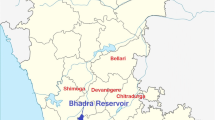Abstract
The efficient utilization of hydropower resources play an important role in the economic sector of power systems, where the hydroelectric plants constitute a significant portion of the installed capacity. Determination of daily optimal hydroelectric generation scheduling is a crucial task in water resource management. By utilizing the limited water resource, the purpose of hydroelectric generation scheduling is to specify the amount of water releases from a reservoir in order to produce maximum power, while the various physical and operational constraints are satisfied. Hence, new forms of release policies namely, BSOPHP, CSOPHP, and SHPHP are proposed and tested in this research. These policies could only use in hydropower reservoir systems. Meanwhile, to determine the optimal operation of each policy, real coded genetic algorithm is applied as an optimization technique and maximizing the total power generation over the operational periods is chosen as an objective function. The developed models have been applied to the Cameron Highland hydropower system, Malaysia. The results declared that by using optimal release policies, the output of power generation is increased, while these policies also increase the stability of reservoir system. In order to compare the efficiency of these policies, some reservoir performance indices such as reliability, resilience, vulnerability, and sustainability are used. The results demonstrated that SHPHP policy had the highest performance among the tested release policies.







Similar content being viewed by others
References
Adeloye A, Soundharajan BS, Ojha C, & Remesan R (2015) Effect of Hedging-Integrated Rule Curves on the Performance of the Pong Reservoir (India) During Scenario-Neutral Climate Change Perturbations. Water resources management, 1–26
Afzali R, Mousavi SJ, Ghaheri A (2008) Reliability-based simulation-optimization model for multireservoir hydropower systems operations: khersan experience. J Water Resour Plan Manag 134(1):24–33
Bayazit M, Ünal N (1990) Effects of hedging on reservoir performance. Water Resour Res 26(4):713–719
Birhanu K, Alamirew T, Dinka MO, Ayalew S, Aklog D (2014) Optimizing reservoir operation policy using chance constraint nonlinear programming for Koga irrigation Dam, Ethiopia. Water Resour Manag 28(14):4957–4970
Chang F-J, Chen L (1998) Real-coded genetic algorithm for rule-based flood control reservoir management. Water Resour Manag 12(3):185–198
Felfelani F, Movahed AJ, Zarghami M (2013) Simulating hedging rules for effective reservoir operation by using system dynamics: a case study of Dez Reservoir, Iran. Lake Reservoir Manage 29(2):126–140
Hashimoto T, Stedinger JR, Loucks DP (1982) Reliability, resiliency, and vulnerability criteria for water resource system performance evaluation. Water Resour Res 18(1):14–20
Hossain MS, El-Shafie A (2013) Intelligent systems in optimizing reservoir operation policy: a review. Water Resour Manag 27(9):3387–3407
Karamouz M, Nazif S, Sherafat MA, Zahmatkesh Z (2014) Development of an optimal reservoir operation scheme using extended evolutionary computing algorithms based on conflict resolution approach: a case study. Water Resour Manag 28(11):3539–3554
Loucks DP (1997) Quantifying trends in system sustainability. Hydrol Sci J 42(4):513–530
Loucks DP, Van Beek E, Stedinger JR, Dijkman JP, & Villars MT (2005) Water resources systems planning and management: an introduction to methods, models and applications: Paris: UNESCO
Maass A, Hufschmidt MM, Dorfman R, Thomas HA Jr, Marglin SA, Fair GM (1962) Design of water-resource systems. Harvard University Press, Cambridge
McMahon TA, Adeloye AJ, Zhou S-L (2006) Understanding performance measures of reservoirs. J Hydrol 324(1):359–382
Neelakantan T, Pundarikanthan N (1999) Hedging rule optimisation for water supply reservoirs system. Water Resour Manag 13(6):409–426
Ping S, Zq J, Ting-ting W, Yan-ke Z (2015) Research and Application of Parallel Normal Cloud Mutation Shuffled Frog Leaping Algorithm in Cascade Reservoirs Optimal Operation. Water resources management, 1–17
Reddy MJ, Kumar DN (2006) Optimal reservoir operation using multi-objective evolutionary algorithm. Water Resour Manag 20(6):861–878
Rittima A (2009) Hedging policy for reservoir system operation: a case study of Mun Bon and Lam chae reservoirs. Kasetsart J (Natural Science) 43(4):833–842
Shiau J-T (2009) Optimization of reservoir hedging rules using multiobjective genetic algorithm. J Water Resour Plan Manag 135(5):355–363
Shiau JT (2011) Analytical optimal hedging with explicit incorporation of reservoir release and carryover storage targets. Water resources research, 47(1)
Shih J-S, ReVelle C (1994) Water-supply operations during drought: continuous hedging rule. J Water Resour Plan Manag 120(5):613–629
Srinivasan K, Philipose M (1996) Evaluation and selection of hedging policies using stochastic reservoir simulation. Water Resour Manag 10(3):163–188
Srivastava D, Awchi TA (2009) Storage-yield evaluation and operation of mula reservoir, India. J Water Resour Plan Manag 135(6):414–425
Tu M-Y, Hsu N-S, Tsai FT-C, Yeh WW-G (2008) Optimization of hedging rules for reservoir operations. J Water Resour Plan Manag 134(1):3–13
You JY, & Cai X (2008) Improve hedging rules for the operation of lake Okeechobee in Southern Florida. Paper presented at the World Environmental and Water Resources Congress 2008@ sAhupua’A.
Zhao T, Cai X, Yang D (2011) Effect of streamflow forecast uncertainty on real-time reservoir operation. Adv Water Resour 34(4):495–504
Author information
Authors and Affiliations
Corresponding author
Rights and permissions
About this article
Cite this article
Tayebiyan, A., Mohammed Ali, T.A., Ghazali, A.H. et al. Optimization of Exclusive Release Policies for Hydropower Reservoir Operation by Using Genetic Algorithm. Water Resour Manage 30, 1203–1216 (2016). https://doi.org/10.1007/s11269-015-1221-6
Received:
Accepted:
Published:
Issue Date:
DOI: https://doi.org/10.1007/s11269-015-1221-6




